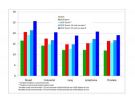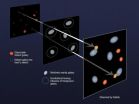(Press-News.org) The estimated total cost of cancer care in the United States in 2020 is expected to be $158 billion assuming the most recent observed patterns of incidence, survival, and cost remain the same. This represents a 27% increase from 2010 due only to the projected aging and growth of the US population, according to a study published online January 12th in The Journal of the National Cancer Institute. However, the authors also note the cost of cancer care could rise even more quickly under some reasonable assumptions such as a 2% annual increase in costs of the initial and final phases of cancer care.
Cancer disproportionately affects the elderly population, which is expected to increase from 40 million in 2009 to 70 million in 2030. With changes in risk factor prevalence and stage at diagnosis, and development of new diagnostic tools and treatments for cancer in the 1990s, in general cancer incidence declined and survival improved, but cancer care became more expensive. Under a different scenario of continuing trends in cancer incidence, survival, and costs of care, the total cost of cancer care in 2020 is expected to be $173 billion, an even larger increase (39% from 2010).
To estimate the national medical cost of cancer care through the year 2020 for 13 cancers in men and 16 cancers in women, Angela Mariotto, Ph.D., and colleagues from the National Cancer Institute, analyzed data on cancer incidence (the rates of newly diagnosed cancer in any given year) and survival from the (SEER) Surveillance, Epidemiology, and End Results database http://seer.cancer.gov/ and Medicare expenditures associated with cancer from the linked SEER-Medicare database http://healthservices.cancer.gov/seermedicare/. They combined prevalence (the population rates of people alive with cancer in any given year) and cancer costs by phase of care and used US Census population projections to calculate cancer care costs through the year 2020.
The researchers projected prevalence by phase of care under different assumptions about future incidence and survival. Incidence is decreasing for most of the cancer sites. But even with declining incidence rates, the absolute number of individuals diagnosed with cancer will continue to increase because of population changes. The researchers also projected costs by phase of care under different assumptions about future trends.
The authors write, "Costs of care for cancer patients who die of their disease follows a "U-shaped" curve, with the highest costs in the initial phase following diagnosis and the phase before death, and the lowest costs in the period in-between, the continuing phase."
Although the per person cost of cancer care varies tremendously by cancer site, the overall national burden is driven by prevalence. For example, the per person cost of female breast cancer care in each phase is among the lowest, but the total cost of breast cancer in 2020 is projected to be the highest ($20.5 billion) ), because of the large number of women living with breast cancer in each phase of care. The highest increases in costs for cancer care between 2010 and 2020 are projected for female breast cancer (32%) and prostate cancer (42%) patients in the continuing phase, representing a higher proportion of long term survivors.
Looking ahead, the authors write that, "To investigate the impact of specific cancer control strategies on cancer survivorship and to estimate the societal return on investments in cancer research, more complex modeling approaches are necessary."
One such approach is a cooperative study funded by the National Cancer Institute with the Cancer Intervention Surveillance Modeling Network, which uses micro-simulation models to investigate the impact of interventions on population-based cohorts of patients with breast, colorectal, prostate and lung cancers. http://cisnet.cancer.gov/ The authors note that while these types of projections are "undoubtedly more reliable" than the projections used in their article, the models require substantial additional research effort, extensive data on populations in the U.S., and could only be done for a limited number of cancer sites.
INFORMATION: Contact:
Article: National Cancer Institute Office of Media Relations, 301-496-6641, ncipressofficers@mail.nih.gov
END
Washington, DC – Tinnitus appears to be produced by an unfortunate confluence of structural and functional changes in the brain, say neuroscientists at Georgetown University Medical Center (GUMC).
The phantom ringing sounds heard by about 40 million people in the U.S. today are caused by brains that try, but fail to protect their human hosts against overwhelming auditory stimuli, the researchers say in the January 13th issue of Neuron. They add that the same process may be responsible for chronic pain and other perceptual disorders.
The researchers say that the absence ...
Based on growth and aging of the U.S. population, medical expenditures for cancer in the year 2020 are projected to reach at least $158 billion (in 2010 dollars) – an increase of 27 percent over 2010, according to a National Institutes of Health analysis. If newly developed tools for cancer diagnosis, treatment, and follow-up continue to be more expensive, medical expenditures for cancer could reach as high as $207 billion, said the researchers from the National Cancer Institute (NCI), part of the NIH. The analysis appears online, Jan. 12, 2011, in the Journal of the National ...
(PHILADELPHIA) –The discovery that high levels of high-density lipoprotein (HDL) cholesterol (the "good cholesterol") is associated with reduced risk of cardiovascular disease has fostered intensive research to modify HDL levels for therapeutic gain. However, recent findings have called into question the notion that pharmacologic increases in HDL cholesterol levels are necessarily beneficial to patients. Now, a new study from researchers at the University of Pennsylvania School of Medicine shows that a different metric, a measure of HDL function called cholesterol efflux ...
A new study identifies a molecule that is a critical regulator of neuron survival after ischemic brain injury. The research, published by Cell Press in the January 13 issue of the journal Neuron, may lead to new therapies that reduce damage after a stroke or other injuries that involve an interruption in blood supply to the brain.
Ischemic brain injury is damage caused by a restriction in blood supply. Neuronal death after an interruption in the supply of oxygen and glucose involves a complex cascade of pathological events and, although previous research has identified ...
NIH-funded researchers were able to eliminate tinnitus in a group of rats by stimulating a nerve in the neck while simultaneously playing a variety of sound tones over an extended period of time, says a study published today in the advance online publication of the journal Nature. The hallmark of tinnitus is often a persistent ringing in the ears that is annoying for some, debilitating for others, and currently incurable. Similar to pressing a reset button in the brain, this new therapy was found to help retrain the part of the brain that interprets sound so that errant ...
SEATTLE – Astronomers who survey galaxies in the distant universe are getting some unexpected help from gravity, according to a new study.
In a presentation at the American Astronomical Society meeting this week and a related paper in the current issue of the journal Nature, researchers say that as many as 20 percent of the most distant galaxies currently detected appear brighter than they actually are, because of an effect called "strong gravitational lensing."
The discovery could change astronomers' notions of how galaxies formed in the early universe.
Haojing Yan, ...
Teeth and bone are important and complex structures in humans and other animals, but little is actually known about their chemical structure at the atomic scale. What exactly gives them their renowned toughness, hardness and strength? How do organisms control the synthesis of these advanced functional composites?
Now, using a highly sophisticated atomic-scale imaging tool on a sea creature's tooth, two Northwestern University researchers have peeled away some of the mystery of organic/inorganic interfaces that are at the heart of tooth and bone structure. They are the ...
New British-led research shows that starting treatment of blood pressure with two medicines rather than the one produces better and faster results and fewer side effects – findings that could change clinical practice world-wide.
The study, published in the Lancet, challenges popular medical practice for the treatment of high blood pressure. The research was led by Cambridge in collaboration with the Universities of Dundee, Glasgow and the British Hypertension Society.
Doctors usually start treatment with one medicine and then add others over a period of months, if needed, ...
Targeted nerve stimulation could yield a long-term reversal of tinnitus, a debilitating hearing impairment affecting at least 10 percent of senior citizens and up to 40 percent of military veterans, according to an article posted in the Jan. 12 online edition of Nature.
Researchers Dr. Michael Kilgard and Dr. Navzer Engineer from The University of Texas at Dallas and University-affiliated biotechnology firm MicroTransponder report that stimulation of the vagus nerve paired with sounds eliminated tinnitus in rats. A clinical trial in humans is due to begin in the next ...
WHAT:
Adding new evidence to the debate on the best treatment for middle-ear infections, or acute otitis media, in young children, clinical researchers at the Children's Hospital of Pittsburgh of the University of Pittsburgh Medical Center have found antibiotics to be more effective than a placebo in relieving symptoms. These findings appear in the January 13th issue of the New England Journal of Medicine. The study was funded by the National Institute of Allergy and Infectious Diseases, part of the National Institutes of Health.
Most American children with middle-ear ...

